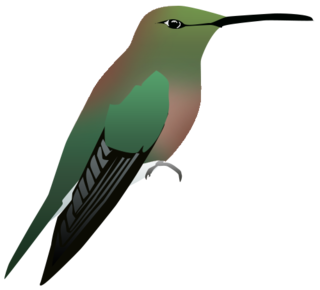 W
WThe Cuban amazon also known as Cuban parrot or the rose-throated parrot, is a medium-sized mainly green parrot found in woodlands and dry forests of Cuba, the Bahamas and Cayman Islands in the Caribbean. Although they have been observed in the wild in Puerto Rico, they are probably the result of escaped pets, and no reproduction has been recorded.
 W
WThe smooth-billed ani is a large near passerine bird in the cuckoo family. It is a resident breeding species from southern Florida, the Caribbean, parts of Central America, south to western Ecuador, Brazil, northern Argentina and southern Chile. It was introduced to Galápagos around the 1960s and is potentially impacting native and endemic species across the archipelago.
 W
WThe Greater Antillean bullfinch is a species of bird in the family Thraupidae. It is found in the Bahamas, the Dominican Republic, Haiti, Jamaica, and the Turks and Caicos Islands. Its natural habitats are subtropical or tropical dry forest, subtropical or tropical moist lowland forest, subtropical or tropical moist montane forest, subtropical or tropical dry shrubland, and heavily degraded former forest.
 W
WThe great lizard cuckoo is a species of cuckoo in the family Cuculidae. The species is also known as the Cuban lizard cuckoo. It is found in The Bahamas and Cuba.
 W
WThe mangrove cuckoo is a species of cuckoo that is native to the Neotropics.
 W
WThe Caribbean dove is a species of bird in the family Columbidae. It is found in the Cayman Islands, Colombia, Honduras, Jamaica, and Mexico. It has been introduced to New Providence in the Bahamas. Its natural habitats are subtropical or tropical dry forest, subtropical or tropical moist lowland forest, and heavily degraded former forest.
 W
WBrace's emerald is an extinct species of hummingbird which was endemic to the main island of the Bahamas, New Providence.
 W
WThe Cuban emerald is a species of hummingbird in the family Trochilidae. It is found in a wide range of semi-open habitats in Cuba, the Isle of Pines, and the western Bahamas. This bird can be observed to be feeding throughout the day, perching on a wire to rest.
 W
WLa Sagra's flycatcher is a passerine bird in the tyrant flycatcher family.
 W
WThe loggerhead kingbird is a species of bird in the family Tyrannidae.
 W
WThe Bahama mockingbird is a species of bird in the family Mimidae. It is found in the Bahamas, Cuba, Jamaica and the Turks and Caicos Islands, and is a vagrant to Florida. Its natural habitats are subtropical or tropical dry forest, subtropical or tropical moist lowland forest, subtropical or tropical dry shrubland, and heavily degraded former forest.
 W
WThe Cuban pewee or crescent-eyed pewee is a species of bird in the family Tyrannidae. It is found in Cuba and the northern Bahamas. It was formerly lumped with the Hispaniolan pewee and Jamaican pewee as a single species, the Greater Antillean pewee.
 W
WThe redhead is a medium-sized diving duck. The scientific name is derived from Greek aithuia an unidentified seabird mentioned by authors including Hesychius and Aristotle, and Latin americana, of America. The redhead is 37 cm (15 in) long with an 84 cm (33 in) wingspan. Redhead weight ranges from 2.0-2.5 lbs, with males weighing an average of 2.4 lbs and females weighing an average of 2.1 lbs. It belongs to the genus Aythya, together with 11 other described species. The redhead and the common pochard form a sister group which together is sister to the canvasback.
 W
WThe Bahama swallow is a swallow found only in the Bahamas.
 W
WThe pearly-eyed thrasher is a bird in the thrasher family Mimidae. It is found on many Caribbean islands, from the Bahamas in the north to the Grenadines in the south, with an isolated population on Bonaire. At least two subspecies can be distinguished genetically: Margarops fuscatus fuscatus which is found between the Greater Antilles and Antigua and Barbuda, M. f. densirostris, occurring from Montserrat and Guadeloupe southwards. Its main habitat is bushes and trees in mountain forests and coffee plantations.
 W
WThe red-legged thrush is a species of bird in the family Turdidae. Native to the Caribbean, it is found in the Bahamas, Cayman Brac, Cuba, Dominica, Hispaniola and Puerto Rico. It formerly occurred on the Swan Islands, Honduras.
 W
WTyto pollens was an extinct giant barn owl which lived in the Bahamas during the last Ice Age.
 W
WThe thick-billed vireo is a small songbird. It breeds in the West Indies in the Bahamas, Turks and Caicos Islands, Cayman Islands, Tortuga Island in Haiti and on cays off the coast of Cuba. It occasionally can be found as a vagrant to south Florida in the United States. The subspecies V. c. approximans of Providencia Island is sometimes treated as a subspecies of the mangrove vireo or as a separate species, the Providencia vireo.
 W
WThe olive-capped warbler is a species of New World warbler that is native to the western and eastern ends of Cuba as well as Grand Bahama and the Abaco Islands in the Bahamas. Its natural habitat is pine forests and occasionally adjacent mixed forests.
 W
WThe pine warbler is a small songbird of the New World warbler family.
 W
WThe West Indian woodpecker is a species of bird in the family Picidae. It is found in the Bahamas, Cayman Islands and Cuba. Its natural habitats are subtropical or tropical dry forest, subtropical or tropical moist lowland forest, subtropical or tropical mangrove forests, and heavily degraded former forest.
 W
WThe Bahama woodstar is a species of hummingbird endemic to the Bahama archipelago, including the Bahama and Turks and Caicos islands. It is named the "Hummer" by locals due to a distinct humming sound it makes while feeding.